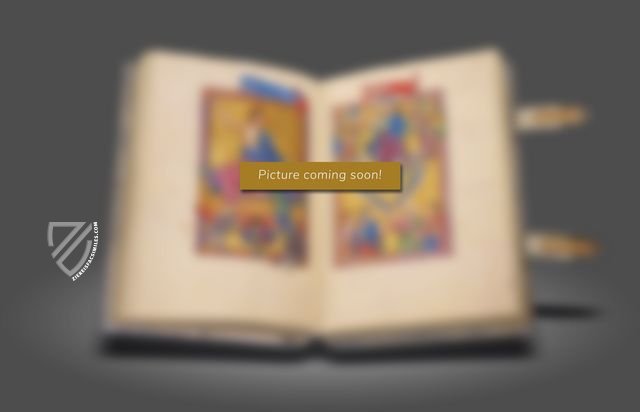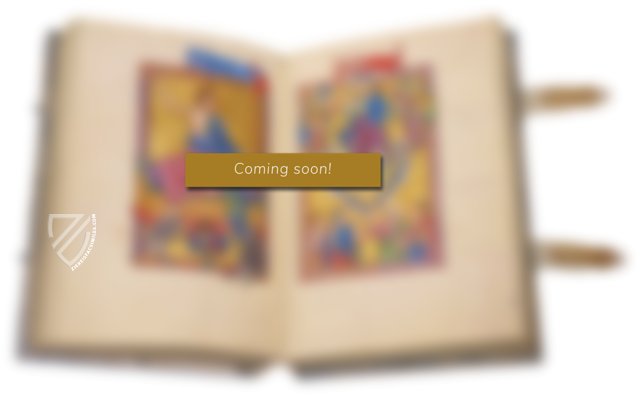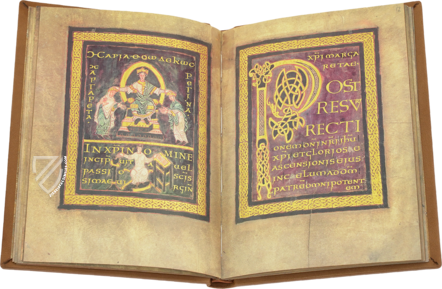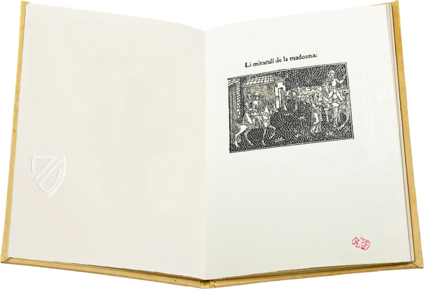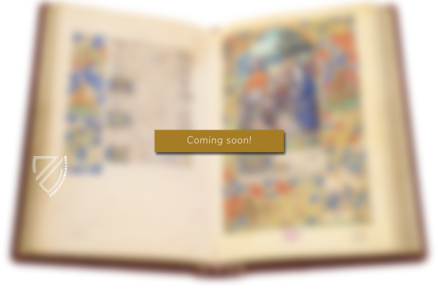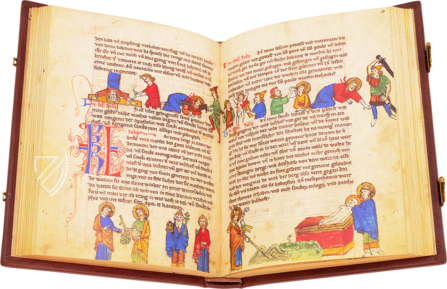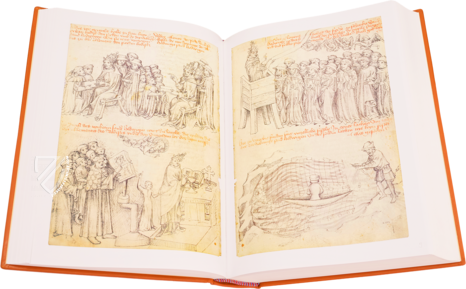The "Katherine Group": St. Katherine, St. Margaret, St. Juliana, Hali Meiðhad and Sawles Warde
(under 1,000€)
After remaining obscure and unstudied for centuries in Oxford’s Bodleian Library, the Katherine Group was rediscovered by the famous author J.R.R. Tolkien in 1929. The five texts date to the 13th century and were composed by an anonymous author in the West Midlands of England. Aside from the significance of the medieval English dialect in which it was written, the manuscript is a rare medieval text directed at a female audience, anchoresses and other religious recluses specifically. All five texts revolve around the virtue and power of virginity and the preservation of one’s piety.
The "Katherine Group": St. Katherine, St. Margaret, St. Juliana, Hali Meiðhad and Sawles Warde
The so-called Katherine Group is a compendium five high medieval texts written in a dialect from the southwest Midlands that linguists believe bridges the gap between Old and Middle English. These fascinating works also attracted the attention of one of the most famous authors of the 20th century, J. R. R. Tolkien (1892-1973), and continues to be studied by linguists, cultural historians, and feminist scholars. This is because the 13th century manuscripts are female focused including the Vitae of three female saints, a sermon entitled Hali Meiðhad, or "Holy Maidenhood", and the Sawles Warde or "Guardianship of the Soul", a sermon on how to best guard one’s soul that would have been particularly appealing for female readers. Although the text is unillustrated, the unfinished work has leftover spaces for large initials to be added later. Although most of the manuscript’s existence remains a mystery, it was donated in 1612 by Thomas Twyne (1543–1613) to Oxford’s Bodleian Library where it remains today.
A Female-Centered Collection of Works
The work begins with three saints’ lives: ff. 1r-18r are concerned with St. Katherine of Alexandria, ff. 18r-36v are concerned with St. Margaret of Antioch, and ff. 36v-52r are concerned with St. Juliana of Nicomedia. All of these saints’ lives affirm the triumph of virginity over the enticements and threats of material wealth and power, thus making them especially appealing to pious noblewomen seeking to escape the normal traps of life for a woman of their station in favor of a life of prayer and piety. Next, ff. 52r-71v contains Hali Meiðhad, which is directed at anchoresses or recluses, praising the virtues of virginity over worldly marriage, and derives from a letter written in the early 12th century by Hildebert of Lavardin (ca. 1055-1133) to the recluse Athalisa. Finally, ff. 72r-80v presents the Sawles Warde, an allegorical text describing the soul as a precious treasure within a castle and encouraging readers to achieve emotional balance in their earthly life and avoid the pitfalls of passion, pride, and despair. This kind of Christian stoicism would have been particularly appealing to female clerics, especially those living hermetic lifestyles.
Rediscovered in the 20th Century
Aside from being the author works such as The Lord of the Rings and The Hobbit, Tolkien was also a distinguished professor of linguistics at Oxford University who first brought attention to MS Bodley 34 in 1929. Tolkien connected the Katherine Group with the Ancrene Wisse or Guide for Anchoresses, another important source on medieval spirituality, and also recognized the unique dialect in which the works are written. The texts show influences from both the Scandinavian and Welsh languages and Tolkien was able to deduce that they were created in the area of Herefordshire, a region bordering Wales that had been settled by Scandinavians centuries earlier. Tolkien coined the term “AB language” to describe this fairly standardized dialect, which is “characterized by French and Norse loanwords, colloquial expressions, conservative spelling, and similarities to Old English syntax” was used in the West Midlands during the 13th century.
Codicology
- Alternative Titles
- The Katherine Group
St. Katherine, St. Margaret, St. Juliana, Hali Meiðhad, Sawles Warde
Die "Katharina-Gruppe": Hl. Katharina, Hl. Margareta, Hl. Juliana, Hali Meiðhad und Sawles Warde - Size / Format
- 162 pages / 15.4 × 10.8 cm
- Origin
- United Kingdom
- Date
- Ca. 1240
- Style
- Genre
- Language
- Script
- Protogothic minuscule Gothic Textura Rotunda
- Illustrations
- Numerous initials and ornamented lines
- Content
- Saint's lives of St. Katherine of Alexandria, St. Margaret of Antioch, St. Juliana of Nicomedia; Sermon 'Hali Meiðhad' (Holy Maidenhood); 'Sawles Warde', a allegory about the body and soul
- Previous Owners
- Thomas Twine
#1 St. Katherine, St. Margaret, St. Juliana, Hali Meiðhad, Sawles Warde
(under 1,000€)
- Treatises / Secular Books
- Apocalypses / Beatus
- Astronomy / Astrology
- Bestiaries
- Bibles / Gospels
- Chronicles / History / Law
- Geography / Maps
- Saints' Lives
- Islam / Oriental
- Judaism / Hebrew
- Single Leaf Collections
- Leonardo da Vinci
- Literature / Poetry
- Liturgical Manuscripts
- Medicine / Botany / Alchemy
- Music
- Mythology / Prophecies
- Psalters
- Other Religious Books
- Games / Hunting
- Private Devotion Books
- Other Genres
- Afghanistan
- Armenia
- Austria
- Belgium
- Belize
- Bosnia and Herzegovina
- China
- Colombia
- Costa Rica
- Croatia
- Cyprus
- Czech Republic
- Denmark
- Egypt
- El Salvador
- Ethiopia
- France
- Germany
- Greece
- Guatemala
- Honduras
- Hungary
- India
- Iran
- Iraq
- Israel
- Italy
- Japan
- Jordan
- Kazakhstan
- Kyrgyzstan
- Lebanon
- Liechtenstein
- Luxembourg
- Mexico
- Morocco
- Netherlands
- Palestine
- Panama
- Peru
- Poland
- Portugal
- Romania
- Russia
- Serbia
- Spain
- Sri Lanka
- Sweden
- Switzerland
- Syria
- Tajikistan
- Turkey
- Turkmenistan
- Ukraine
- United Kingdom
- United States
- Uzbekistan
- Vatican City
- A. Oosthoek, van Holkema & Warendorf
- Aboca Museum
- Ajuntament de Valencia
- Akademie Verlag
- Akademische Druck- u. Verlagsanstalt (ADEVA)
- Aldo Ausilio Editore - Bottega d’Erasmo
- Alecto Historical Editions
- Alkuin Verlag
- Almqvist & Wiksell
- Amilcare Pizzi
- Andreas & Andreas Verlagsbuchhandlung
- Archa 90
- Archiv Verlag
- Archivi Edizioni
- Arnold Verlag
- ARS
- Ars Magna
- ArtCodex
- AyN Ediciones
- Azimuth Editions
- Badenia Verlag
- Bärenreiter-Verlag
- Belser Verlag
- Belser Verlag / WK Wertkontor
- Benziger Verlag
- Bernardinum Wydawnictwo
- BiblioGemma
- Biblioteca Apostolica Vaticana (Vaticanstadt, Vaticanstadt)
- Bibliotheca Palatina Faksimile Verlag
- Bibliotheca Rara
- Boydell & Brewer
- Bramante Edizioni
- Bredius Genootschap
- Brepols Publishers
- British Library
- C. Weckesser
- Caixa Catalunya
- Canesi
- CAPSA, Ars Scriptoria
- Caratzas Brothers, Publishers
- Carus Verlag
- Casamassima Libri
- Centrum Cartographie Verlag GmbH
- Chavane Verlag
- Christian Brandstätter Verlag
- Circulo Cientifico
- Club Bibliófilo Versol
- Club du Livre
- CM Editores
- Collegium Graphicum
- Collezione Apocrifa Da Vinci
- Comissão Nacional para as Comemorações dos Descobrimentos Portugueses
- Coron Verlag
- Corvina
- CTHS
- D. S. Brewer
- Damon
- De Agostini/UTET
- De Nederlandsche Boekhandel
- De Schutter
- Deuschle & Stemmle
- Deutscher Verlag für Kunstwissenschaft
- DIAMM
- Droz
- E. Schreiber Graphische Kunstanstalten
- Ediciones Boreal
- Ediciones Grial
- Ediclube
- Edições Inapa
- Edilan
- Editalia
- Edition Deuschle
- Edition Georg Popp
- Edition Leipzig
- Edition Libri Illustri
- Editiones Reales Sitios S. L.
- Éditions de l'Oiseau Lyre
- Editions Medicina Rara
- Editorial Casariego
- Editorial Mintzoa
- Editrice Antenore
- Editrice Velar
- Edizioni Edison
- Egeria, S.L.
- Eikon Editores
- Electa
- Emery Walker Limited
- Enciclopèdia Catalana
- Eos-Verlag
- Ephesus Publishing
- Ernst Battenberg
- Eugrammia Press
- Extraordinary Editions
- Fackelverlag
- Facsimila Art & Edition
- Facsimile Editions Ltd.
- Facsimilia Art & Edition Ebert KG
- Faksimile Verlag
- Feuermann Verlag
- Folger Shakespeare Library
- Franco Cosimo Panini Editore
- Friedrich Wittig Verlag
- Fundación Hullera Vasco-Leonesa
- G. Braziller
- Gabriele Mazzotta Editore
- Gebr. Mann Verlag
- Gesellschaft für graphische Industrie
- Getty Research Institute
- Giovanni Domenico de Rossi
- Giunti Editore
- Graffiti
- Grafica European Center of Fine Arts
- Guido Pressler
- Guillermo Blazquez
- Gustav Kiepenheuer
- H. N. Abrams
- Harrassowitz
- Harvard University Press
- Helikon
- Hendrickson Publishers
- Henning Oppermann
- Herder Verlag
- Hes & De Graaf Publishers
- Hoepli
- Holbein-Verlag
- Houghton Library
- Hugo Schmidt Verlag
- Idion Verlag
- Il Bulino, edizioni d'arte
- ILte
- Imago
- Insel Verlag
- Insel-Verlag Anton Kippenberger
- Instituto de Estudios Altoaragoneses
- Instituto Nacional de Antropología e Historia
- Introligatornia Budnik Jerzy
- Istituto dell'Enciclopedia Italiana - Treccani
- Istituto Ellenico di Studi Bizantini e Postbizantini
- Istituto Geografico De Agostini
- Istituto Poligrafico e Zecca dello Stato
- Italarte Art Establishments
- Jan Thorbecke Verlag
- Johnson Reprint Corporation
- Josef Stocker
- Josef Stocker-Schmid
- Jugoslavija
- Karl W. Hiersemann
- Kasper Straube
- Kaydeda Ediciones
- Kindler Verlag / Coron Verlag
- Kodansha International Ltd.
- Konrad Kölbl Verlag
- Kurt Wolff Verlag
- La Liberia dello Stato
- La Linea Editrice
- La Meta Editore
- Lambert Schneider
- Landeskreditbank Baden-Württemberg
- Leo S. Olschki
- Les Incunables
- Liber Artis
- Library of Congress
- Libreria Musicale Italiana
- Lichtdruck
- Lito Immagine Editore
- Lumen Artis
- Lund Humphries
- M. Moleiro Editor
- Maison des Sciences de l'homme et de la société de Poitiers
- Manuscriptum
- Martinus Nijhoff
- Maruzen-Yushodo Co. Ltd.
- MASA
- Massada Publishers
- McGraw-Hill
- Metropolitan Museum of Art
- Militos
- Millennium Liber
- Müller & Schindler
- Nahar - Stavit
- Nahar and Steimatzky
- National Library of Wales
- Neri Pozza
- Nova Charta
- Oceanum Verlag
- Odeon
- Orbis Mediaevalis
- Orbis Pictus
- Österreichische Staatsdruckerei
- Oxford University Press
- Pageant Books
- Parzellers Buchverlag
- Patrimonio Ediciones
- Pattloch Verlag
- PIAF
- Pieper Verlag
- Plon-Nourrit et cie
- Poligrafiche Bolis
- Presses Universitaires de Strasbourg
- Prestel Verlag
- Princeton University Press
- Prisma Verlag
- Priuli & Verlucca, editori
- Pro Sport Verlag
- Propyläen Verlag
- Pytheas Books
- Quaternio Verlag Luzern
- Reales Sitios
- Recht-Verlag
- Reichert Verlag
- Reichsdruckerei
- Reprint Verlag
- Riehn & Reusch
- Roberto Vattori Editore
- Rosenkilde and Bagger
- Roxburghe Club
- Salerno Editrice
- Saltellus Press
- Sandoz
- Sarajevo Svjetlost
- Schöck ArtPrint Kft.
- Schulsinger Brothers
- Scolar Press
- Scrinium
- Scripta Maneant
- Scriptorium
- Shazar
- Siloé, arte y bibliofilia
- SISMEL - Edizioni del Galluzzo
- Sociedad Mexicana de Antropología
- Société des Bibliophiles & Iconophiles de Belgique
- Soncin Publishing
- Sorli Ediciones
- Stainer and Bell
- Studer
- Styria Verlag
- Sumptibus Pragopress
- Szegedi Tudomànyegyetem
- Taberna Libraria
- Tarshish Books
- Taschen
- Tempus Libri
- Testimonio Compañía Editorial
- Thames and Hudson
- The Clear Vue Publishing Partnership Limited
- The Facsimile Codex
- The Folio Society
- The Marquess of Normanby
- The Richard III and Yorkist History Trust
- Tip.Le.Co
- TouchArt
- TREC Publishing House
- TRI Publishing Co.
- Trident Editore
- Tuliba Collection
- Typis Regiae Officinae Polygraphicae
- Union Verlag Berlin
- Universidad de Granada
- University of California Press
- University of Chicago Press
- Urs Graf
- Vallecchi
- Van Wijnen
- VCH, Acta Humaniora
- VDI Verlag
- VEB Deutscher Verlag für Musik
- Verlag Anton Pustet / Andreas Verlag
- Verlag Bibliophile Drucke Josef Stocker
- Verlag der Münchner Drucke
- Verlag für Regionalgeschichte
- Verlag Styria
- Vicent Garcia Editores
- W. Turnowski Ltd.
- W. Turnowsky
- Waanders Printers
- Wiener Mechitharisten-Congregation (Wien, Österreich)
- Wissenschaftliche Buchgesellschaft
- Wissenschaftliche Verlagsgesellschaft
- Wydawnictwo Dolnoslaskie
- Xuntanza Editorial
- Zakład Narodowy
- Zollikofer AG

